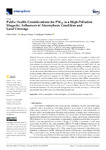Mostrar o rexistro simple do ítem
Public Health Considerations for PM₁₀ in a High-Pollution Megacity: Influences of Atmospheric Condition and Land Coverage
| dc.contributor.author | Zafra Mejía, Carlos Alfonso | |
| dc.contributor.author | Suárez-López, Joaquín | |
| dc.contributor.author | Pachón, Jorge E. | |
| dc.date.accessioned | 2021-02-01T18:56:40Z | |
| dc.date.available | 2021-02-01T18:56:40Z | |
| dc.date.issued | 2021 | |
| dc.identifier.citation | Zafra C, Suárez J, Pachón JE. Public Health Considerations for PM₁₀ in a High-Pollution Megacity: Influences of Atmospheric Condition and Land Coverage. Atmosphere. 2021; 12(1):118. https://doi.org/10.3390/atmos12010118 | es_ES |
| dc.identifier.uri | http://hdl.handle.net/2183/27257 | |
| dc.description | Restrictions apply to the availability of these data. Data was obtained from Red de Monitoreo de Calidad del Aire de Bogotá (RMCAB) and are available at http://201.245.192.252:81/Report/stationreport with the permission of RMCAB. | |
| dc.description.abstract | [Abstract] This paper analyzes the PM₁₀ concentrations and influences of atmospheric condition (AC) and land coverage (LC) on a high-pollution megacity (Bogota, Colombia) from a public health viewpoint. Information of monitoring stations equipped with measuring devices for PM₁₀/temperature/solar-radiation/wind-speed were used. The research period lasted eight years (2007–2014). AC and LC were determined after comparing daily PM₁₀ concentrations (DPM₁₀) to reference limits published by the World Health Organization (WHO). ARIMA models for DPM₁₀ were also developed. The results indicated that urban sectors with lower atmospheric instability (AI) had a 2.85% increase in daily mortality (DM) in relation to sectors with greater AI. In these sectors of lower AI, impervious LC predominated, instead of vegetated LC. An ARIMA analysis revealed that a greater extent of impervious LC around a station led to a greater effect on previous days’ DPM₁₀ concentrations. Extreme PM₁₀ episodes persisted for up to two days. Extreme pollution episodes were probably also preceded by low mixing-layer heights (between 722–1085 m). The findings showed a 13.0% increase in WHO standard excesses (PE) for each 10 µg/m³ increase in DPM₁₀, and a 0.313% increase in DM for each 10% increase in PE. The observed average reduction of 14.8% in DPM₁₀ (−0.79% in DM) was probably due to 40% restriction of the traffic at peak hours. | es_ES |
| dc.description.uri | http://201.245.192.252:81/Report/stationreport | |
| dc.language.iso | eng | es_ES |
| dc.publisher | MDPI | es_ES |
| dc.relation.uri | https://doi.org/10.3390/atmos12010118 | es_ES |
| dc.rights | Atribución 4.0 Internacional | es_ES |
| dc.rights.uri | http://creativecommons.org/licenses/by/4.0 | * |
| dc.subject | ARIMA | es_ES |
| dc.subject | Atmospheric condition | es_ES |
| dc.subject | Daily mortality | es_ES |
| dc.subject | Land coverage | es_ES |
| dc.subject | PM₁₀ | es_ES |
| dc.subject | Bogotá | es_ES |
| dc.title | Public Health Considerations for PM₁₀ in a High-Pollution Megacity: Influences of Atmospheric Condition and Land Coverage | es_ES |
| dc.type | info:eu-repo/semantics/article | es_ES |
| dc.rights.access | info:eu-repo/semantics/openAccess | es_ES |
| UDC.journalTitle | Atmosphere | es_ES |
| UDC.volume | 12 | es_ES |
| UDC.issue | 1 | es_ES |
| dc.identifier.doi | 10.3390/atmos12010118 |






